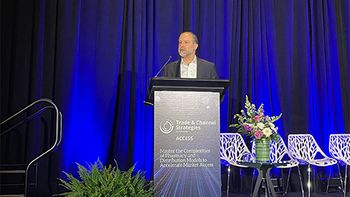
- Pharmaceutical Commerce - March/April 2017
A conversation with Dan Renick, Precision for Value
Dan Renick, trained as a pharmacist, began his career in community and long-term care pharmacy before entering the pharma industry, eventually rising to corporate account executive in the managed markets division of Merck. Experience in working with large employers, business coalitions and benefits consultants led to a corporate role at Humana with responsibility for trade relations and pharmacy provider organizations. From there, he joined Hobart Group Holdings, eventually serving as president. Hobart was acquired by Precision for Medicine in 2013, and this and other assets became Precision for Value, a consulting and marketing services organization for life sciences companies, which he heads. Over this 20+-year career, Dan has accumulated a wealth of information on a wide range of industry stakeholders through a combination of direct experience, context, and insightful interpretation.
Pharmaceutical Commerce sat down with Dan to talk about the dynamics in today’s payer and provider markets; here’s what he had to say.
1) Precision for Value is a relatively new organization, coming together from Precision for Medicine assets in mid-2014. Give us some history of how and why the organization was formed.
This warrants sharing a little of the business history prior to the Precision launch you mention. Hobart Group Holdings, often just referred to as Hobart in the industry, was launched more than 14 years ago as the industry’s first dedicated payer marketing agency in response to growing formulary pressures pharma faced from payers. It’s hard to believe looking back but this highly needed specialized offering was only about 12 people strong when I joined as a partner nine years ago, and since then the core payer agency of record offering has grown about 20-fold.
Why? Because the market pressures on formulary access and affordability have skyrocketed and we’ve been able to assemble and grow a tremendous talent base to support clients with a constant singular focus on market access. Then Precision enters the picture and Hobart basically served as the platform business to launch what is now known as Precision for Value. In addition to our legacy payer marketing work, we now offer robust services in pricing, product strategy, market analytics, and health economics/outcomes research (HEOR).
Precision for Value was formed to more comprehensively address the complex issues pharma and life sciences companies are facing in demonstrating and communicating value to a diverse set of global decisionmakers, and we truly have an unrivaled passion for ensuring appropriate patients can both access and afford medical innovations. Through organic growth and acquisitions, we now have more than 400 professionals in North America and Europe supporting clients with global market access needs.
I think what differentiates us to clients is the investment we make in individuals with direct former payer experience to serve as the nucleus for market access strategy development and tactical execution. This group, which we refer to as our Payer Strategy Team, is comprised of seasoned professionals hailing from various functional areas like pharmacy, medical and quality, and numerous customer types ranging from traditional payers to organized systems of care to specialty pharmacies and more.
2) What is the “product” of a Precision for Value engagement? Does the organization do primarily strategic consulting, or are there operational or executional services being performed as well?
As mentioned, clients hire us to help them address a range of complex market access issues so this will vary by engagement. I’ll describe what a comprehensive engagement looks like, and then you can see how individual activities might in some cases be engaged on a standalone basis. To use a product launch example, we’re frequently engaged at 18–24 months prelaunch to develop broad product strategy and value evidence plans, often including pricing development. This basically creates the roadmap for various key markets around the world but frequently with an emphasis on the US launch. Think of this as the comprehensive tactical plan that will include things like value message development, payer market research, pre-market awareness campaigns, customer segmentation, account manager tools, training and trade materials, especially for products to be handled by specialty pharmacies.
Our work doesn’t stop after the launch since the big task of convincing HCPs to prescribe the product remains. A major shift we’ve seen is that it’s no longer enough to provide doctors with just clinical information; now they also want to know the cost to their patients along with any formulary restrictions like prerequisite therapy. So upon product launch, we’ll support specific cost and coverage messaging to prescribers—often referred to as pull through—so that there’s clear understanding at the most local level what a patient will likely pay for a medication and what restrictions might be encountered.
This then becomes a lifecycle activity where new data is developed either through additional clinical trials or real-world evidence, updated value messages are communicated to payers, access is reinforced or improved, and pull-through efforts are expanded. In some cases, we’ve been supporting individual brands for more than eight years as part of this lifecycle partnership with clients.
3) Precision for Value seems to be focused on the latest trends in pharmaceutical research—targeted therapies, precision medicine, genomics, rare diseases. What makes these fields different from the broad scope of all pharma drug development? And, if I’m a pharma company with a “conventional” small-molecule, common disease state (say, diabetes or cardiovascular), should I be talking to Precision?
Yes, please talk to us about both! You’re spot on that advances in technology and the related R&D activities are driving medical innovations that at times truly seem to be in the realm of science fiction versus just science, and as our name suggests, we certainly have a stated focus on the emerging areas of precision medicine. In fact, we’re excited that one of our clients will likely bring forward the first US-approved gene therapy to correct a form of inherited retinal disease, with the potential of restoring visual function—truly a great advancement.
Yet with these advances come many new questions about affordability, value demonstration, patient selection, payment mechanisms, public policy, and the role of various industry participants in ensuring these game-changing breakthroughs will change patients’ lives. Precision for Value is uniquely positioned to support clients and innovations of this type because our wide range of experts can develop innovative value, payment and policy frameworks to ensure new treatments aren’t just approvable, but reimbursable. After all, what’s the point of all the R&D investments and advances if there’s not a viable market access landscape?
Within the more conventional small-molecule markets and related primary-care conditions, we still have lots to tackle in therapeutic areas like diabetes, lipid management, chronic heart failure and many others. Not surprisingly, our early years as a company largely focused on this area of the market and it remains roughly half of our business, so we’re well equipped and experienced to support more traditional products with very large treatment populations. In fact, this continues to comprise the majority of market access activities with the emphasis on optimal formulary access that eases restrictions and limits cost-sharing for patients, while encouraging adherence, quality and positive outcomes that benefit all parties.
Our differentiation here is the years of direct payer experience that provide our clients with the necessary insights to address payer concerns. Basically, if key payer questions of today aren’t well understood, then how will they effectively be addressed or tailored to specific roles like that of a quality director or actuary, or for influential stakeholders like integrated delivery systems? There’s simply no substitute for direct experience in these areas given the complexities of the marketplace. Providing that expertise to clients with on-staff support is how we help them achieve their collective mission of improving patient care.
4) The company has made recent acquisitions and staffed up in HEOR—a topic that historically has seemed to be of great interest in academic and policy circles; less so for companies worried about getting reps to knock on doctors’ office doors or negotiating a payer contract. What is the place of HEOR in today’s market and inside pharma companies, and where does Precision for Value see this field growing?
You’re right on target with respect to what many consider the traditional emphasis of HEOR, that being more academic focused and not always of high interest to critical stakeholders like payers, providers and integrated health systems. Let’s just generally refer to this group as the “commercial set.” In recent years, the role of HEOR in supporting value demonstration to the commercial set has grown exponentially as healthcare budgets have become more strained and competing products have become more numerous. While the large European markets have been out ahead of this for many years, the US commercial set is catching up quickly by demanding rigorous value demonstration through various HEOR activities, and we want to ensure our clients are prepared to adequately respond to these demands.
To fully address this, we acquired an established business of more than 10 years, Precision Health Economics, which just happened to have a similar name! A good example of the role of HEOR with the commercial set is the recent introduction of treatments for Hepatitis C that finally represented a true cure. Yet the value was hotly debated because all the focus was on price, initially around $1000/day of treatment over roughly 90 days.
In response, our health economists developed very innovative and compelling models that demonstrated value well beyond the price of treating individuals infected with HCV to extend to those who would avoid future infection thanks to reduced transmission rates, which represents significant future cost avoidance. Prior to our work this was largely overlooked or not properly accounted for.
5) Drug pricing is Topic No. 1 among many observers inside and outside the industry. Alternative reimbursement schemes are being proposed and sometimes acted on. Is Precision for Value promoting these alternative schemes? Are there areas of opportunity, or roadblocks, to pay attention to?
What’s this about drug pricing being a hot topic? Clearly a little humor on my part, especially as a former corporate pharmacy director at Humana! We are involved in various activities that broadly seek to shift some aspect of payment to value and outcome elements, and I’ll come back to that. I’ll first say that even before these value-based alternatives can be considered there has to be some alignment on the interplay between price and value. Warren Buffet said “Price is what you pay. Value is what you get.” So, differences in value attribution between pharma and various purchasers are really fueling the pricing debate.
In this area, value frameworks and methodologies must be agreed to by all parties before advancing fee-for-value concepts. Here’s where we’re playing a role in both value frameworks and alternate payment models, or APM. With respect to value demonstration, our Precision Health Economics group recently launched the Innovation and Value Initiative, or IVI, with a focus on finding common ground in approaches to measuring value in healthcare—including value measurements that matter to patients. We agree that costs should reflect value and this important multi-stakeholder initiative will advance how value is measured. With respect to APM, some news reports have focused on high-profile activities geared towards major outcomes like CV event avoidance, and those are exciting but still rare. More common first steps away from straight fee-for-service reimbursement that we’ve been a part of take into account things like appropriate dosing linked to product indications, appropriate percentage of patients to be treated within a given population, and similar alternatives that continue to reward innovation yet acknowledge that utilization should be directed towards the most appropriate patient types and in the most cost-effective manner.
6) Specialty pharmacy has exploded in the past few years, not without some controversy over too-close relationships between manufacturers and the SPs they work with. How does Precision for Value see the specialty pharmacy channel evolving?
As a pharmacist, I will always emphasize the critical role played by our profession in helping patients across all pharmacy channels. To the SP channel overall, we definitely expect specialty pharmacies to remain a critical and growing industry participant given the ongoing growth in highly specialized products, especially in the pipeline.
However, we do expect some potential disruption that partly stems from poorly structured manufacturer-SP relationships but also driven by large employers, the biggest private purchasers of these products. While it’s been the case for several years now, employers have recently started to organize around a common theme, that being they don’t routinely pay for such large expenditures in their business without being more involved in the procurement process. So while this is a developing story, we’re actively working with clients to form new relationships with various employer channel stakeholders to ensure the value of medical innovation is directly and accurately discussed versus relying on other third-party players to filter this information.
7) Similarly, there has been extraordinary attention in recent months on the influence of pharmacy benefit managers (PBMs) in drug commercialization. Is there a rational way for pharma companies to weigh the pluses and minuses of discounts that PBMs seek, the formulary positions they offer (as well as the formulary exclusion lists), and pharma companies’ efforts to maintain their pricing strategies?
This one is a sticky wicket for sure because we have a major intermediary in the form of PBMs that don’t necessarily have business interests aligned to the overall healthcare trends that are focused more on value and outcomes. Attacks on the PBM industry and model are coming from all over and tend to focus on two fronts. The first is how rebates are secured and accounted for and what benefit, if any, accrues to patients versus the PBM. The second relates to the frequent ownership of specialty pharmacies by PBMs that bring along all sorts of perverse incentives, and to my earlier comments we may well see large employers significantly disrupt this model in the not too distant future.
All that said, the PBM model isn’t going away anytime soon so pharma will continue with these collaborations and here are the things we’re keeping in mind as we guide our clients through this evolving landscape. The first is to know what you’re getting with respect to potential formulary positions, positive or negative, so that the outcome can be effectively pulled through or mitigated, and this requires meaningful data and analytics investments to improve business results. The second is to strategically engage other stakeholders that view value differently from the traditional PBM view. An example is integrated delivery systems that bear financial responsibility for longer lengths of stay and readmissions, many of whom are also very large employers that can directly or indirectly influence formulary design. The third is to consider where quality collaborations may influence drug selection, and this is growing in importance with entities like ACOs and Medicare Advantage sponsors that have meaningful linkages between quality and financial performance. So while PBMs have consolidated greatly and definitely wield significant influence, they’re not the sun of the payer universe.
8) Let’s talk about data and analytics. There is a flood of services being developed to draw data from health records, to collate real world evidence, and to ferret out prescribers’ actions and mindsets in how drugs should be marketed. Does Precision for Value have its own set of services? Do you have a perspective on which of the many services being offered have the highest potential value?
We definitely have a focus in this area since the industry has steadily moved from once not having enough data to now not having enough insights from the available data. So we tend to be data agnostic from a source standpoint and focus instead on extraction of key elements to enable better insights that inform business activities. I’ll share two quick examples. The first is our Cost & Coverage Platform, a proprietary system that enables data mapping from various prescription claims data sets in a way that ultimately delivers very specific and accurate information to prescribers. As I mentioned earlier HCPs, and particularly those in health systems like IDNs, are paying attention to what their patients will pay on average for a drug and what, if any, restrictions need to be addressed. This innovative technology utilizes data that most clients already have, personalizes it for the field force and improves business performance as a result.
The second is Qnav, our branded, proprietary quality navigator tool that provides clarity to quality performance metrics and identifies opportunities for improvement, which our clients then use as the basis for quality improvement collaborations with their customers. It’s a remarkable tool that the National Committee for Quality Assurance (NCQA) recently decided to collaborate on in a first-ever agreement to incorporate their Health Effectiveness Data and Information Set (HEDIS) into our Qnav platform, which furthers NCQA’s mission to improve quality!
9) Finally, are you optimistic that the pharma industry will be able to continue developing new therapies in the face of extreme pricing pressure? What excites you about where pharma research is going—and where healthcare itself is heading?
I’m more optimistic than ever that medical innovation will remain strong despite the current raft of negative attacks on the pharma industry. Yes, the industry needs to adjust in some areas like pricing and evolve in effective value demonstration, but private enterprises are pretty good at making necessary adjustments when the stakes are so large. What really drives my optimism is the industry’s collective desire to address so many major unmet medical needs and the consensus among Americans that this will be worth the cost. Why the consensus? Because nearly everyone has a personal experience with a healthcare crisis where a more effective treatment, or any treatment, could have made a difference.
For me and so many others, it’s the dreaded Alzheimer’s diagnosis, with the telltale early symptoms we try to ignore as long as possible. That’s been the case in my family and so many other families, and it’s certainly not limited to AD…cancer can still be very deadly while rare diseases continue to confound us. But I’m encouraged and privileged to see first-hand how so many innovators are getting up every day to tackle these unmet needs with passion, and Precision for Value shares that passion and we make it our purpose to help clients help patients.
Save
Save
Articles in this issue
over 8 years ago
GS1 standards are vital for pharma serializationover 8 years ago
The ‘site-less’ clinical trial process moves aheadover 8 years ago
The growing role of clinical trial educatorsover 8 years ago
Thermal blankets find a growing cold chain roleover 8 years ago
2017 Hub Services reportover 8 years ago
Pharma ups the ante on DTC advertisingover 8 years ago
Serialization status in ‘Year Zero’Newsletter
Stay ahead in the life sciences industry with Pharmaceutical Commerce, the latest news, trends, and strategies in drug distribution, commercialization, and market access.





